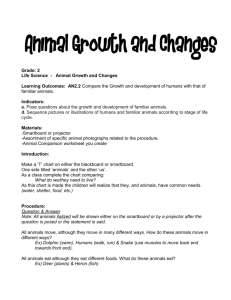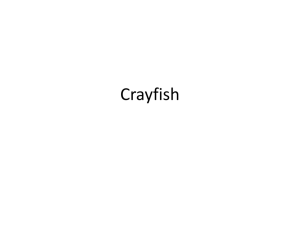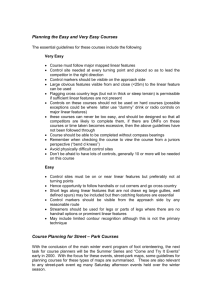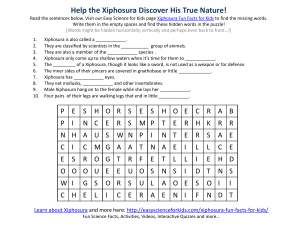Arthropod Jeopardy - Jutzi
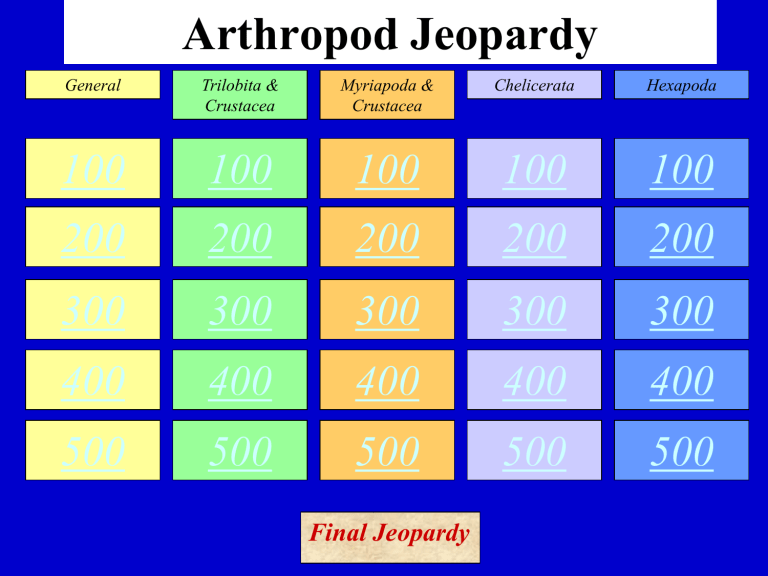
General
Arthropod Jeopardy
Chelicerata Trilobita &
Crustacea
Myriapoda &
Crustacea
Hexapoda
2
What % of all animals are arthropods?
3
80%
4
What does the word “Arthropoda” actually mean?
5
Jointed legs
6
Why must all arthropods molt?
7
They must shed their hard exoskeleton so they can grow
8
What is an advantage and a disadvantage of the compound eye?
9
Advantage – Ultra wide viewing angle
Disadvantage – Poor image resolution
10
Compare & contrast complete and incomplete metamorphosis
11
Incomplete – 3 stages (egg, nymph, & adult) where the nymph looks like the adult but wingless
Complete – 4 stages (egg, larva, pupa, adult) where the larva looks nothing like the adult
12
What are the three parts of the trilobite body plan?
13
14
What is the name of the extinction event that killed the trilobites, how long ago was it, and what was the cause of the extinction?
15
The Permian-Triassic extinction event occurred
250 mya and was caused by a super volcano in
Siberia
16
Name at least 4 members of
Subphylum Crustacea
17
Lobsters, crabs, shrimp, crayfish, barnicles, krill, sea monkeys, etc…
18
What is the name of the largest
Arthropod living today?
19
Deep sea spider crab
20
How has the study of trilobites led to a better understanding of plate tectonic theory?
21
Since trilobite fossils have been found on the top of Mt. Everest, it shows that Mt. Everest was once underwater and that the
Earth is a dynamic and everchanging planet.
22
What two types of organisms are found in subphylum Myriapoda?
23
Centipedes & Millipedes
24
What does the name
“Myriapoda” actually mean?
25
Many legs
26
In what way are all crustaceans bound to the sea?
27
All crustaceans must utilize the sea for reproduction
28
How can you tell the difference between male and female crayfish?
29
The first pair of swimmerets on male crayfish are enlarged for sperm deposition.
30
Complete the following chart:
Diplopoda
Common name
# Legs per segment
Coloration
Body shape
Diet
Chilopoda
31
Common name
Chilopoda
Centipedes
# Legs per segment 1 pair or 2 legs
Coloration
Body shape
Diet
Drab/Earth tones
Flattened
Carnivorous
Diplopoda
Millipedes
2 pair or 4 legs
Bright/Colorful
Tubular
Herbivorous
32
What are the two main body segments found in
Chelicerates?
33
34
What adaptation do all
Chelicerates have that allows them to breathe on land?
35
Book lungs
36
What two diseases are carried by ticks and which of the two is more deadly?
37
Lyme Disease and
Rocky Mountain Spotted Fever.
Rocky Mountain is worse!!!
38
What types of organisms are found in the arachnid orders Scorpiones, Acari, and Araneae?
39
Scorpiones – scorpions
Acari – ticks, mites, & chiggers
Araneae - spiders
40
What types of organisms are found in the following Chelicerata Classes:
Eurypterida
Xiphosura
Pycnogondia
41
Eurypterida – Giant sea scorpions
Xiphosura – Horseshoe crabs
Pycnogondia – Sea spiders
42
What does the word
“Hexapoda” actually mean and what type of organisms are considered hexapods?
37
Hexapoda means “six legs” and the hexapods are commonly known as insects
44
What are the three main body segments found in hexapods?
45
Head, thorax, & abdomen
46
What four major mouthpart adaptations may be seen in hexapods?
47
Chewing, sponging, siphoning, and piercing
48
What are spiracles and how does bug spray exploit spiracles to kill insects?
49
Spiracles are tiny holes in an insect’s exoskeleton through which oxygen enters the body.
Insect spray clogs up these holes causing the insect to suffocate.
50
Describe how a honeybee’s waggle dance can show other bees where food is located?
51
The bee conveys direction by the angle of the dance in relation to the sun.
The bee conveys distance by the number of waggles in each dance cycle.
52
From what arthropod Subphylum did the hexapods evolve and how did this evolution proceed?
53
The hexapods evolved from the myriapods.
The elongated body of myriapod ancestors broke into three regions. The legs on the head region evolved into complex mouthparts, the three pairs of legs on the thorax grew large enough to support the whole body, and the legs on the abdomen reabsorbed into the organism as it evolved.

